M. M. Ahmed 1, S. K. Das 1, M. A. Haydar 2, M. M. H. Bhuiyan 2, M. I. Ali 2, D. Paul 2
1Department of Physics, Jagannath University, Dhaka, Bangladesh
2Health Physics & Radioactive Waste Management Unit, INST, BAEC, Savar, Dhaka, Bangladesh
Correspondence to: M. M. Ahmed , Department of Physics, Jagannath University, Dhaka, Bangladesh.
| Email: |  |
Copyright © 2014 Scientific & Academic Publishing. All Rights Reserved.
Abstract
The radionuclide contents and their activity concentrations in beach sand, sediment and adjacent soil samples collected from Inani sea beach, Cox’s Bazar, Bangladesh were determined by using a high resolution germanium detector (HPGe) of 20% relative efficiency. A total of eighteen samples of three categories were collected and analysed. The activity concentrations of 226Ra, 232Th and 40K in the sand samples of the beach were found to be varied from 15.14 ± 2.62 to 28.67 ± 3.09 Bqkg-1, 24.39 ± 2.50 to 49.46 ± 3.58 Bqkg-1 and 362.00 ± 79.61 to 560.87 ± 81.40 Bqkg-1 respectively. For sediment samples the activity concentrations of the corresponding radionuclides ranged between 18.09 ± 2.66 to 53.32 ± 4.01 Bqkg-1, 31.01 ± 2.73 to 78.37 ± 4.35 Bqkg-1, 390.26 ± 76.37 to 733.61 ± 85.80 Bqkg-1, respectively where as for soil samples the values were 26.11 ± 2.99 to 61.66 ± 5.88 Bqkg-1, 41.93 ± 4.18 to 89.39 ± 6.15 Bqkg-1 and 467.16 ± 77.62 to 1304.11 ± 147.07 Bqkg-1 respectively. The calculated average absorbed dose rates due to these radionuclides in the three types of samples were found as 52.24 nGyh-1, 62.96 nGyh-1, and 104.97 nGyh-1, respectively. The estimated outdoor annual effective dose ranged from 0.05 to 0.08 mSvy-1, 0.05 to 0.11 mSvy-1 and 0.07 to 0.17 mSvy-1 with the mean values of 0.06 mSvy-1, 0.08 mSvy-1, and 0.13 mSvy-1 for sand, sediment, and soil samples, respectively. The values of radium equivalent activity in almost all the samples were less than 370 Bq.kg-1. On the other hand, the values of external hazard index for sand, sediment, and soil samples varied between 0.22 to 0.37, 0.25 to 0.54, and 0.33 to 0.78 with the average values of 0.30, 0.37, and 0.59, respectively. The values are less than unity in all the samples that indicate the non-hazardous nature of the samples.
Keywords:
Natural Radionuclides, Radioactivity Concentration, Gamma Spectroscopy, Radium Equivalent Activity, Radiation Hazard Index, Absorbed Dose, Annual Effective Dose
Cite this paper: M. M. Ahmed , S. K. Das , M. A. Haydar , M. M. H. Bhuiyan , M. I. Ali , D. Paul , Study of Natural Radioactivity and Radiological Hazard of Sand, Sediment, and Soil Samples from Inani Beach, Cox’s Bazar, Bangladesh, Journal of Nuclear and Particle Physics, Vol. 4 No. 2, 2014, pp. 69-78. doi: 10.5923/j.jnpp.20140402.04.
1. Introduction
Natural radioactivity is present in the human environment due to the presence of cosmogenic and primordial radionuclides in the earth’s crust [1]. Cosmogenic radionuclides are produced by the interaction of cosmic-rays with atomic nuclei in the atmosphere, while primordial ones (terrestrial background radiation) were formed by the process of nucleo-synthesis. Human activities like mining and milling of mineral ores, ore processing and enrichment etc. cause the redistribution of the activity concentration on the earth crust. Most of the radioactivity deposited on surface sediment is washed by rains and drained through rivers to the oceans. The naturally occurring radionuclides are relatively and uniformly distributed in the seas and oceans. Radionuclides on reaching the oceans become part of the marine ecosystem (water, sediments, sands and biota) and may transfer- through seawater-sediments-biota interface to human beings [2]. Accumulation of such substances in the marine costal environment raises many problems concerning the safety of biotic life, food chain and ultimately human. Due to the fact that radionuclides can have harmful effects on the habitat and can also pose health hazard problems for human, the assessment of gamma radiation dose from natural sources is of particular importance as natural radiation is the largest contributor to the external dose of the world population [3, 4].Beaches are deposition landforms, and are the result of wave action by which waves or currents move sand or other loose sediments of which the beach is made of as these particles are held in suspension. Beach materials come from erosion of rocks offshore, as well as from headland erosion and slumping producing deposits of scree. These deposits found at different levels within the sand contain natural radionuclides that contribute to ionizing radiation exposure on earth [5].Inani beach, recently recognized as one of the most popular tourist spots in Bangladesh, is located at a distance of 35 km to the south of Cox’s Bazar sea beach, the longest sea beach in the world. The beach composed of light gray to gray sands [6] has become an attractive spot for tourist due to its fine sands and calm and quiet natural environment. The beach sand is fine to medium in size and its gray color indicates the presence of considerable quantity of fine material mixed with the sand. Since the sand, sediment and the soil adjacent to the beach may contain elevated level of natural radioactivity, therefore, the aim of the present study is to investigate the presence of probable natural radionuclides (226Ra, 232Th and 40K) and their activity concentration levels in the collected samples and finally determine the radiological effect on the tourist, public and the environment due to these radionuclides [7].
2. Methods and Materials
2.1. Study Area
Inani beach is the area of interest in the present study, which is located in Ukhia Thana under Cox’s Bazar district of Chittagong division. The locations of sample collection under current study are shown in Figure 1 and 2.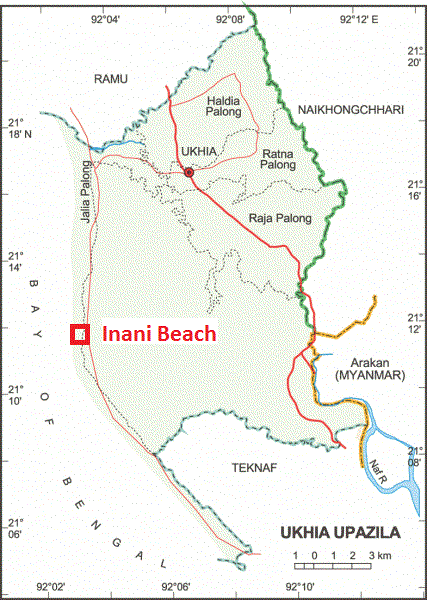 | Figure 1. Location map the Inani Beach, Cox’s Bazar, Bangladesh |
 | Figure 2. Location map of sampling (using Google map) at the Inani Beach, Cox’s Bazar, Bangladesh |
2.2. Sampling Locations
A total of 18 samples (5-sand, 6-soil and 7-sediment) were collected from the beach area during the period of 11/04/2013 to 13/04/2013. In the present work the soil samples were collected from the adjacent area of the beach, most of which is the cultivated land, whereas sand and sediment samples were collected from the beach area and shore line of the sea, respectively. The coordinates of the sampling area of Inani beach is in between 21°8′55.52″N to 21°9′49.79″N and 92°4′19.11″E to 92°3′21.33″E.
2.3. Sample Collection and Processing
About 1 to 1.25 kg of sample was collected from each sampling location. The samples were collected from equidistant locations with a distance of 100 m from each other and at a depth of 10-15 cm from the surface. Upon collection, all the samples were properly packed and marked for their identification code. The samples were then transported, stored and processed at the sample preparation laboratory of Health Physics and Radioactive Waste management Unit (HPRWMU), Bangladesh Atomic Energy Commission (BAEC), Savar, Dhaka. The samples were cleaned for stones, gravels, grass-roots, vegetation etc. and then dried in the sun for several days. The samples were then crushed and ground to fine grains using a grinding machine. The samples were mixed homogeneously and passed through a sieve of 200 µm mesh size. The samples were dried again in a temperature controlled oven at 104℃ temperature for 24 hours in order to eliminate any traces of water. Upon drying the samples were transferred to sealable cylindrical plastic containers of 7 cm height and 5.5 cm in diameter and the weights (after grinding) of the samples were recorded using an electrical balance. The sample-filled plastic containers were sealed tightly with cap and wrapped with thick vinyl tape around their necks; marked individually with identification number, sample location, date of preparation and net weight and then stored for about 30 days to assume secular equilibrium between 238U and 232Th series and their daughter progenies.
2.4. Experimental Procedure
The detection and measurement of radionuclides in the samples were carried out by gamma spectrometry system using a p-type co-axial HPGe detector of 93 cm3 active volume and 20% relative efficiency supplied by CANBERRA (Model GC-2018 and serial No. 0408941). The co-axial geometry with electrical contacts in the form of concentric cylinders closed at the end makes it possible to produce very large volume detector elements with excellent efficiencies for high-energy photons. The HPGe had a resolution of 2 keV at 1332 keV of Cobalt-60 gamma-ray line. The detector was coupled to a 16 k-channel analyser. The spectra of all samples were perfectly analysed using Genie-2000 spectra analysis software (which matched various gamma energy peaks to a library of all possible radionuclides) to calculate the concentrations of 226Ra, 232Th and 40K. The detector was enclosed in a cylindrical shielding container made of lead and iron and having a moving cover to reduce the external gamma-ray background. All the samples were counted for 10 ks. Prior to the measurement of the samples, the environmental gamma background at the laboratory site was determined with an identical empty plastic container used in the sample measurement. The energy regions selected for the corresponding radionuclides were 295 keV and 352 keV of 214Pb and 609 keV, 1120 keV and 1764 keV for 214Bi for 226Ra, 583 keV and 2614 keV of 208Tl, 911 keV and 969 keV of 228Ac for 232Th, and 1460 keV for 40K [8]. These are shown in Figure 3(a). | Figure 3(a). Energy diagram of the sample in HPGe detector with 20% efficiency |
2.4.1. Calibration of the Detector
The efficiency calibration of the detector was carried out by standard source of solid matrix prepared using 226Ra standard solution. The standard source was prepared using identical container used for the measurement of the samples. The preparation process of standard sources had been reported elsewhere [9]. The efficiency calibration curve as a function of energy for solid matrix is shown in Figure 3(b). The energy calibration of the detector was performed by 137Cs and 60Co point sources.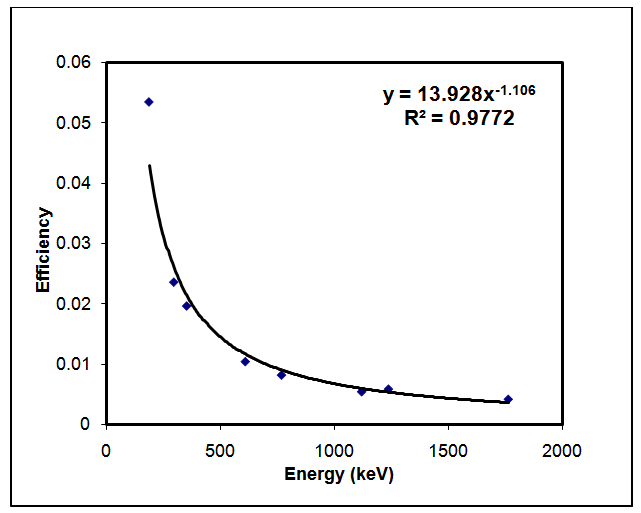 | Figure 3(b). Efficiency curve of the HPGe detector for Solid matrix |
2.4.2. Calculation of Elemental Concentrations
The activity concentration (A) of each radionuclide in the samples was determined by using the net count (cps) (found by subtracting the background counts from the gross counts with same counting time under the selected photo peaks), weight of the sample, the photo-peak efficiency and the gamma intensity at a specific energy as [10]: | (1) |
Where, A = activity of the sample in Bqkg-1cps = the net counts per second = cps for the sample – cps for the background value.E=the counting efficiency of the gamma energy I= absolute intensity of the gamma ray and W= samples net weight (in kg).The errors in the measurement have been expressed in terms of standard deviation (±2 ), where
), where  is expressed as [11]:
is expressed as [11]: | (2) |
Where, Ns is the counts measured in time Ts and Nb is the background counts measured in the Tb,. The standard deviation (±2 ), in cps was converted into activity in Bqkg-1 according to equation (1).
), in cps was converted into activity in Bqkg-1 according to equation (1).
2.4.3. Calculation of Radiological Hazard
Radiological impacts of the radionuclides found in the samples were calculated on the basis of calculation of radium equivalent activity, dose rate calculation, and effective dose rate and hazard indexes as following:The radionuclides 226Ra, 232Th and 40K are not homogeneously distributed in soil, sand and sediments samples. The inhomogeneous distribution from naturally occurring radionuclides is due to disequilibrium between 226Ra and its decay products. For uniformity in exposure estimates, the radionuclide concentrations are defined in terms of ‘Radium equivalent activity’ (Raeq) in Bqkg-1. This allows comparison of the specific activity of materials containing different amounts of 226Ra, 232Th and 40K according to Beretka and Mathew as follows [12]: | (3) |
Where, CRa, CTh and CK are the specific activities of 226Ra, 232Th and 40K, respectively in Bqkg-1.The absorbed dose rate was calculated from the measured activities of 226Ra, 232Th and 40K in the surface soil, sand, and sediment samples using the formula given below [13]: | (4) |
Where, D is absorbed dose rate (nGyh-1,). In natural environmental radioactivity situations, the effective dose is calculated from the absorbed dose by applying the factor is 0.7 Sv/Gy [14]. To estimate the annual effective dose rate, the conversion co-efficient from absorbed dose, 0.7 SvGy-1 and outdoor occupancy factor 0.2 proposed by UNSCEAR, 2000 were used by considering that the people on the average, spent 20% of their time outdoors [15]. The effective dose rate in units of mSvy-1 was calculated by the following formula:  | (5) |
The external hazard index, Hex, is defined as [16]: | (6) |
The value of this index must be less than unity in order to keep the radiation hazard insignificant.
3. Results and Discussions
The results of the present study on the three types (Sand, Sediment and Soil) of samples are summarized in following sections.
3.1. Activity Concentrations in Sand, Sediment and Soil Samples
The activity concentrations of 226Ra, 232Th and 40K of all the samples were calculated in Bqkg-1 with a counting error of two sigma (±2σ) and are shown in the Table 1, 2 & 3. The bar diagrams (Figure 4, 5 & 6) show the distribution of the concentrations of all the radionuclides present in the collected samples.| Table 1. Activity Concentration (Bqkg-1) in Different Sand Samples of Inani Beach |
| | | Activity concentration in Bqkg-1 | | Sample code | Ra-226 | Th-232 | K-40 | | IN SAND 01 | 15.14 ± 2.62 | 26.70 ± 2.65 | 362.00 ± 79.61 | | IN SAND 02 | 25.16 ± 3.05 | 49.46 ± 3.58 | 534.21 ± 82.70 | | IN SAND 03 | 28.67 ± 3.09 | 48.42 ± 4.32 | 516.34 ± 78.87 | | IN SAND 04 | 22.18 ± 2.87 | 34.23 ± 2.95 | 560.87 ± 81.40 | | IN SAND 05 | 17.68 ± 2.70 | 24.39 ± 2.50 | 414.43 ± 76.81 | | Average | 21.76 ± 2.87 | 36.64 ± 3.20 | 477.57 ± 79.88 | | World AVG | 35 | 30 | 400 |
|
|
| Table 2. Activity Concentration (Bqkg-1) in Different Sediment Samples of Inani Beach |
| | | Activity concentration in Bqkg-1 | | Sample code | Ra-226 | Th-232 | K-40 | | IN SEDI 01 | 24.61 ± 2.84 | 43.60 ± 3.20 | 475.50 ± 75.66 | | IN SEDI 02 | 53.32 ± 4.01 | 78.37 ± 4.35 | 450.48 ± 79.60 | | IN SEDI 03 | 29.95 ± 3.34 | 58.85 ± 3.96 | 412.10 ± 83.69 | | IN SEDI 04 | 18.19 ± 2.83 | 32.86 ± 2.97 | 481.60 ± 85.80 | | IN SEDI 05 | 18.09 ± 2.66 | 31.01 ± 2.73 | 390.26 ± 76.37 | | IN SEDI 06 | 25.29 ± 3.02 | 46.73 ± 3.39 | 733.61 ± 85.80 | | Average | 28.17 ± 3.12 | 48.57 ± 3.43 | 490.59 ± 81.04 | | World AVG | 35 | 30 | 400 |
|
|
| Table 3. Activity Concentration in Bqkg-1 in Different Soil Samples of Inani Beach |
| | | Activity concentration in Bqkg-1 | | Sample code | Ra-226 | Th-232 | K-40 | | IN SOIL 01 | 38.86 ± 4.30 | 64.81 ± 4.65 | 919.32 ± 115.16 | | IN SOIL 02 | 44.05 ± 5.66 | 66.84 ± 5.68 | 1229.75 ± 162.46 | | IN SOIL 03 | 61.66 ± 5.88 | 89.39 ± 6.15 | 1304.11 ± 147.02 | | IN SOIL 04 | 49.10 ± 5.54 | 73.30 ± 5.65 | 1006.96 ± 146.09 | | IN SOIL 05 | 48.86± 5.35 | 77.37 ± 5.68 | 1214.30 ± 143.36 | | IN SOIL 06 | 42.09 ± 4.68 | 74.92 ± 6.65 | 909.09 ± 124.22 | | IN SOIL 07 | 26.11 ± 2.99 | 41.93 ± 4.18 | 467.16 ± 77.62 | | Average | 44.39 ± 4.91 | 69.79 ± 5.52 | 1007.25 ± 130.85 | | World AVG | 35 | 30 | 400 |
|
|
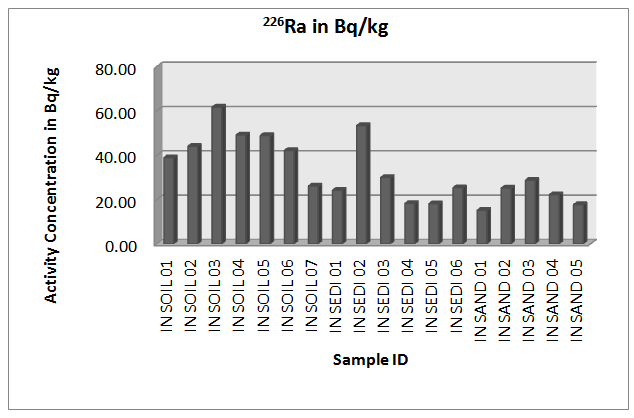 | Figure 4. Distribution  in all samples of Inani beach, Cox’s Bazar, Bangladesh in all samples of Inani beach, Cox’s Bazar, Bangladesh |
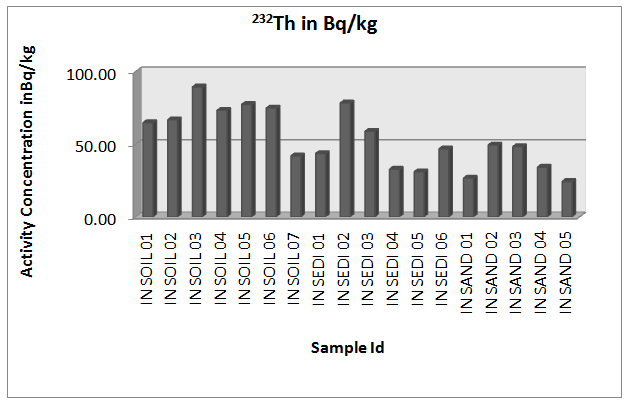 | Figure 5. Distribution  in all samples of Inani beach, Cox’s Bazar, Bangladesh in all samples of Inani beach, Cox’s Bazar, Bangladesh |
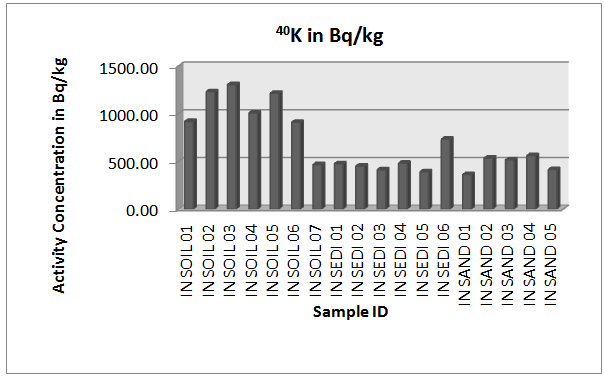 | Figure 6. Distribution  in all samples of Inani beach, Cox’s Bazar Bangladesh in all samples of Inani beach, Cox’s Bazar Bangladesh |
The activity concentrations of 226Ra, 232Th, and 40K in sand samples were found to be varied from 15.14 ± 2.62 Bqkg-1 to 25.16 ± 3.05 Bqkg-1, 24.39 ± 2.50 Bqkg-1 to 49.46 ± 3.58 Bqkg-1, and 362.00 ± 79.61 Bqkg-1 to 560.87 ± 81.40 Bqkg-1 with the average values of 21.26 ± 2.87 Bqkg-1, 36.64 ± 3.20 Bqkg-1, and 477.57 ± 79.80 Bqkg-1, respectively. The average values are almost same as measured by K. M. N. Islam et al at Kuakata Sea-Beach of Bangladesh [17]. The activity concentrations of 226Ra, 232Th, and 40K in sediment samples were ranged from 18.09 ± 2.66 Bq.Kg-1 to 53.32 ± 4.01 Bq.Kg-1, 31.01 ± 2.73 to 78.37 ± 4.35 Bq.Kg-1 and 390.26 ± 76.37 to 733.61 ± 85.80 Bq.Kg-1 with an average of 28.17 ± 3.12 BqKg-1, 48.57 ± 3.43 BqKg-1, and 490.59 ± 81.04 BqKg-1, respectively. These average values are almost similar the values found in another study on the sediment samples collected from a tourist spot in Bangladesh [18].The activity concentrations of 226Ra, 232Th, and 40K in soil samples ranged from 26.11 ± 2.99 Bqkg-1 to 61.66 ± 5.88 Bqkg-1, 41.93 ± 4.18 Bqkg-1 to 89.39 ± 6.15 Bqkg-1, and 467.16 ± 77.62 Bqkg-1 to 1304.11 ± 147.07 Bqkg-1 with the average values of 44.39 ± 4.91 Bqkg-1, 69.79 ± 5.52 Bqkg-1, and 1007.25 ± 130.85 Bqkg-1, respectively. The results found in the current study show that the activity levels in sea-beach soil are almost same as the main land soil as per other report [19].The correlation of naturally occurring radionuclides has been shown in Figures 7, 8 and 9. 226Ra and 232Th were strongly correlated with correlation coefficient R2 value of 0.945. This strong correlation might be due to they have some similarity in there environmental origin [23]. A good correlation between 226Ra and 232Th is shown in Figure. 7. The relationship between 226Ra and 40K, were weak with correlation coefficient of 0.613. The weak correlation (0.613) between Radium and potassium might be explained due to high potassium solubility [23]. The weak correlation existed between 232Th and 40K in the samples ((R2 = 0.585)shown in Figure. 9, which indicated 40K concentrations might not be related to the presence of 232Th [24].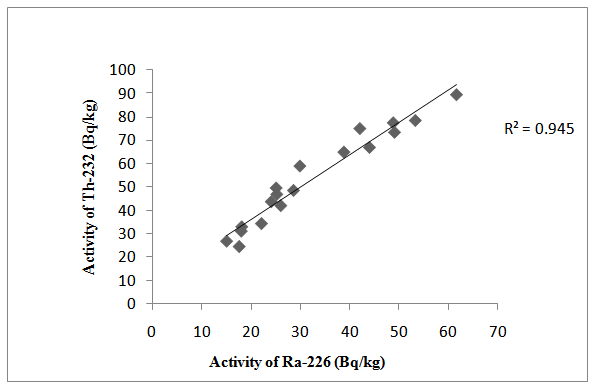 | Figure 7. Correlation between activity concentrations  in all samples in all samples |
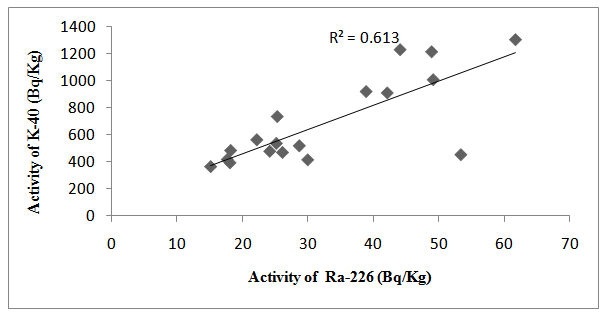 | Figure 8. Correlation between activity concentrations in all samples in all samples |
 | Figure 9. Correlation between activity concentrations  in all samples in all samples |
Moreover, the values of activity concentrations of 226Ra, 232Th, and 40K found in the current study for few samples were higher than the worldwide average value of 35, 30 and 400 Bqkg-1, successively [20].
3.2. Radiological Indices
The radiological parameters such as indices of radium equivalent activity (Raeq), absorbed dose rate (D), outdoor annual effective dose (E), and external hazard index (Hex) were calculated to estimate the radiological risk due to the presence of 226Ra, 232Th and 40K in the samples. Table 4 depicts the values of Raeq, D, E, and Hex.| Table 4. Absorbed dose rate (D), outdoor annual effective dose (E), radium equivalent activity (Raeq) and external hazard index (Hex) of the samples collected from Inani Beach Cox’s Bazar |
| | Sample ID | Radium equivalent activity,

Raeq (Bqkg-1) | Hazard Index,Hex | Absorbed dose rate, D (nGyh-1) | Annual effective dose, E (mSvyr-1) | | INSAND 01 | 81.12 | 0.22 | 38.32 | 0.05 | | INSAND 02 | 136.90 | 0.37 | 63.93 | 0.08 | | INSAND 03 | 137.56 | 0.37 | 64.18 | 0.08 | | INSAND 04 | 114.23 | 0.31 | 54.48 | 0.07 | | INSAND 05 | 84.40 | 0.23 | 40.30 | 0.05 | | AVG | 110.84 | 0.30 | 52.24 | 0.06 | | IN SEDI 01 | 123.03 | 0.33 | 57.47 | 0.07 | | IN SEDI 02 | 199.93 | 0.54 | 90.89 | 0.11 | | IN SEDI 03 | 145.72 | 0.39 | 66.69 | 0.08 | | IN SEDI 04 | 102.18 | 0.28 | 48.48 | 0.06 | | IN SEDI 05 | 92.42 | 0.25 | 43.48 | 0.05 | | IN SEDI 06 | 148.48 | 0.40 | 70.72 | 0.09 | | AVG | 135.29 | 0.37 | 62.96 | 0.08 | | IN SOIL 01 | 202.17 | 0.55 | 95.71 | 0.12 | | IN SOIL 02 | 234.13 | 0.63 | 112.37 | 0.14 | | IN SOIL 03 | 289.68 | 0.78 | 137.25 | 0.17 | | IN SOIL 04 | 231.27 | 0.63 | 109.25 | 0.13 | | IN SOIL 05 | 252.80 | 0.68 | 120.31 | 0.15 | | IN SOIL 06 | 219.05 | 0.59 | 102.88 | 0.13 | | IN SOIL 07 | 121.95 | 0.33 | 57.01 | 0.07 | | AVG | 221.58 | 0.59 | 104.97 | 0.13 | | World AVG | 370 | ... | 55 | 0.07 |
|
|
The values of radium equivalent activity sand, sediment, and soil were found to be varied from 81.12 Bqkg-1 to 137.56 Bqkg-1, 92.42 Bqkg-1 to 199.93 Bqkg-1 and 121.95 Bqkg-1 to 289.68 Bqkg-1with an average of 110.84 Bqkg-1, 135.29 Bqkg-1, and 221.58 Bqkg-1, respectively which were lower than the world average value of 370 Bqkg-1 [21] reported by OECD.The calculated values of external hazard index for sand, sediment and soil samples ranged from 0.22 to 0.37, 0.25 to 0.54, and 0.33 to 0.78 with an average of 0.30, 0.37, and 0.59, respectively which were lower than the world wide average value 1 [20].The absorbed dose rate due to the terrestrial gamma rays at 1m above from the ground were in the range of 40.30 to 64.18 nGyh-1, 43.48 to 90.89 nGyh-1 and 57.01 to 137.25 nGyh-1with the average values of 52.24 nGyh-1, 62.96 nGyh-1 and 104.97 nGyh-1, respectively and the values (Sediment and Soil Samples) are higher than the world average value of 55 nGyh-1 [22].The outdoor annual effective dose equivalent was calculated from the air absorbed doses using the relation given in equation (5). The values varied from 0.05 to 0.08 mSvy-1, 0.05 to 0.11 mSvy-1 and 0.07 to 0.17 mSvy-1with the mean values of 0.06 mSvy-1, 0.08 mSvy-1 and 0.13 mSvy-1 for sand, sediment, and soil samples, respectively. The values in two types of samples are just higher than the worldwide average values for outdoor annual effective dose of 0.07 mSvy-1 [20].The values of hazard index are lower than the unity, absorbed dose rate and annual effective dose found (Sediment and Soil samples) in the present study just exceed the standard limits for radiological safety. Therefore, though insignificant, these environmental components are unable to produce higher radiation exposure effect to the public living around the area. Therefore, no harmful radiation effects are posed to the public and tourists going to the beaches for recreation.
4. Conclusions
The activity concentrations and radiological hazard associated with beach sand, sediment and adjacent soil samples collected from the Inani Sea-Beach, Cox’s Bazar of Bangladesh were investigated in the present study. The results indicated that only the natural radionuclides were present in the samples. The radioactivity concentrations of 226Ra, 232Th and 40K were just similar to the world average values. The activity levels in sand and sediment samples were also comparable to the other parts of the country. The calculated average absorbed dose rate and estimated outdoor annual effective dose were found lower than the worldwide average values. The average radium equivalent activity (Req) and external hazard (Hex) index were less than the world average value. Therefore, the probability of the radiological impact on the inhabitants/public living in this area will be insignificant and there is no probability of radiological health effect on the tourists.
References
| [1] | Mirjana B, Radenković, Saeed Masud Alshikh, Veibor B. Andrić and Šćepan S. Miljanić., Radioactivity of sand from several renowned public beaches and assessment of the corresponding environment risks Journal of Serbian Chemical Society. JSCS.74 (4)461-470(2009) JSCS-3847, doi:10.2298/JSC0904461R. |
| [2] | Turner, J.E., Atoms, Radiation and Radiation Protection, J. Wiley, New York, 1-13(1995). |
| [3] | UNSCEAR, Report of the General Assembly with ScientificAnnexes.http://www.unscear.org/docs/reports/annexb.pdf(2000). |
| [4] | Pfennig, H., Klewe-Nebenius, H., Seelmann-Eggebert, W., Karlsruher Nuklidkarte, 6. Auflage (1995). |
| [5] | Peterson, J.M., Mac Donell, M., Haroun, L., Monette, F., Hildebrand, R.D., Taboas, A., Radiological and Chemical Fact Sheets to Support Health Risk Analyses for Contaminated Areas, Human Health Fact Sheet, Argonic, 38-39(2007). |
| [6] | M. N. Alam, M. I. Chowdhury, M. Kamal, S. Ghose, M. N. Islam and M. N. Mustafa, The 226Ra, 232Th and 40K Activities in Beach Sand Minerals and Beach Soils of Cox’s Bazar, Bangladesh, Journal Environmental Radioactivity, Vol.46,No.2,1999,pp.243-250.doi:10.1016/S0265-931X(98)00143-X. |
| [7] | Kannan, V., Rajan, M.P., Lyengar, M.A. and Ramesh, R. Distribution of natural and anthropogenic radionuclides in soil and beach sand Samples of Kalpakkam (India). Appl. Rodiat. Isot. 57,109-119 (2002). |
| [8] | C.E. Roessier, Z.A. Smith, W.E. Bloch and R.J Prince, Uranium and radium in Floride phosphate materials, Health Phys. vol. 37, 1970, pp. 269-277. |
| [9] | S. Harb, K.S. Din and A. Abbady, Study of efficiency calibrations of HPGe detectors for radioactivity measurement of environmental samples, Proceedings of the 3rd Environmental Physics Conference, 19-23 Feb. 2008, Aswan, Egypt. |
| [10] | International Atomic Energy Agency, Measurement of Radionuclide in Food and the Environment: A Guide- book, International Atomic Energy Agency, Vienna, 1989, pp. 139-144. doi:10.4236/jep.2012.39126 published Online September 2012 (http://www.SciRP.org/journal/jep). |
| [11] | G. F. Knoll, Radiation Detection and Measurement, Third edn.1998, New York. |
| [12] | Beretka, J. and Mathew, P.J., Natural radioactivity of Australian buildings, materials, industrial wastes and by products, Health Physic, 48, 87-95 (1985). |
| [13] | UNSCEAR, 2000. Sources and Effects of Ionizing Radiation. United Nations Scientific Committee on the Effects of Atomic Radiation, United Nations, New York. |
| [14] | UNSCEAR, 1993. Sources and Effects of Ionizing Radiation. United Nations Scientific Committee on the Effects of Atomic Radiation, United Nations, New York. |
| [15] | K. Debertin and R.G. Helmer. Gamma and X-ray spectrometry detectors, North Holland, 1988. |
| [16] | Lu, X. And Xiolan, Z. (2006): Measurement of natural radioactivity in sand samples collected from the Booje Weithe sand park, China, Environ. Geol. 50, 977-988. |
| [17] | Khondaker Mohammed Nazrul Islam, Debasish Paul, Md. Mahbubur Rahman Bhuiyan, Amina Akter, Budrun Neher, Sheikh Mohammad Azharul Islam. Study of Environmental Radiation on Sand and Soil Samples from Kuakata Sea Beach of Patuakhali. Journal of Environmental Protection, 2012, 3, 1078-1084. |
| [18] | Alamgir Miah, M. M. H. Miah, Masud Kamal, M. I. Chowdhury, M. Rahmatullah; Natural Radioactivity and Associated Dose Rates in Soil Samples of Malnichera Tea Garden Sylhet District of Bangladesh, Journal of Nuclear and Particle Physics 2012, 2(6): 147-152, DOI: 10.5923/j.jnpp.20120206.03. |
| [19] | M. I. Chowdhury, M. Kamal, M. N. Alam, Saleha Yeasmin and M. N. Mostafa, Distribution of Naturally Occurring Radionuclides in Soils of Southern Districts of Bangladesh. Radiation Detection Dosimetry (2005), 1of 5.doi:10.1093/rpd/nci335. |
| [20] | UNSCEAR, Sources and effects of ionizing radiation, Report of the United Nations Scientific Committee on the Effects of Atomic Radiation to the General Assembly, United Nations, New York, USA, (2000). Annex. |
| [21] | United Nations Scientific Committee on the Effects of Atomic Radiation (UNSCEAR), Sources, Effects and Risks of Ionising Radiation, United Nations, New York, 1988. |
| [22] | M. R. Abdil, H. Faghihian, M. Kamali, M. Mostajbod-davati and A. Hasanzadeh, Distribution of Natural Radionuclides on Coasts of Bushehr, Persian Gulf, Iran, Iranian Journal of Science & Technology: Transaction A, Vol. 30, No. A3, 2006, pp. 259-269. |
| [23] | M. H El Mamoney, Ashraf E. M. Khater, Environmental Characterization and Radio-ecological Impacts of Non-nuclear Industries on the Red Sea Coast. Journal of Environmental Radioactivity 73(2004) 151-168. |
| [24] | S. Harb, Natural Radioactivity and External Gamma Radiation Exposure at The Costal Red Sea in Egypt. Radiation Protection Dosimetry (2008), Vol 130, No 3, pp. 376-384. |






 ), where
), where  is expressed as [11]:
is expressed as [11]:
 ), in cps was converted into activity in Bqkg-1 according to equation (1).
), in cps was converted into activity in Bqkg-1 according to equation (1).




 in all samples of Inani beach, Cox’s Bazar, Bangladesh
in all samples of Inani beach, Cox’s Bazar, Bangladesh
 in all samples of Inani beach, Cox’s Bazar, Bangladesh
in all samples of Inani beach, Cox’s Bazar, Bangladesh
 in all samples of Inani beach, Cox’s Bazar Bangladesh
in all samples of Inani beach, Cox’s Bazar Bangladesh
 in all samples
in all samples
 in all samples
in all samples
 in all samples
in all samples Abstract
Abstract Reference
Reference Full-Text PDF
Full-Text PDF Full-text HTML
Full-text HTML